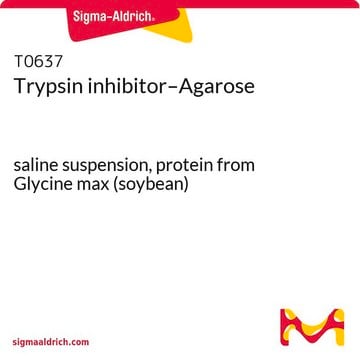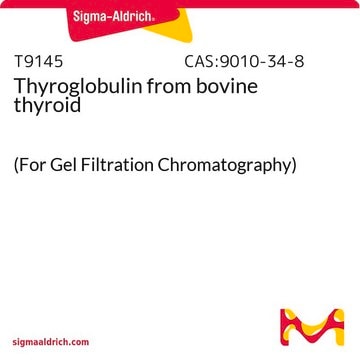10109886001
Roche
Trypsin Inhibitor
from soybean
Sinônimo(s):
trypsin
Faça loginpara ver os preços organizacionais e de contrato
About This Item
Código UNSPSC:
12352207
Produtos recomendados
fonte biológica
soybean
Nível de qualidade
forma
lyophilized
peso molecular
Mr 20,100
embalagem
pkg of 50 mg
fabricante/nome comercial
Roche
concentração
1 mg/mL
técnica(s)
cell culture | mammalian: suitable
pH
3.8-4.5
solubilidade
water: soluble
temperatura de armazenamento
2-8°C
Categorias relacionadas
Descrição geral
Soybean trypsin inhibitor (STI) comprises 181 amino acids. It is a monomeric protein corresponding to a molecular weight of 20 kDa and has two disulfide bridges. It belongs to serpins − serine protease inhibitors family.
Especificidade
Soybean trypsin inhibitor is an inhibitor for trypsin, plasmin, and plasma kallikrein. It inhibits trypsin, factor Xa, plasmin, and plasma kallikrein activity in serum-free cell culture media. It does not inhibit metallo-, cysteine, aspartic proteases, or tissue kallikrein (serine proteases).
Aplicação
Trypsin Inhibitor from soybean is used to terminate tissue disaggregation and for subcultivation procedures.
Trypsin Inhibitor has been used:
- in the buffer for hepatocyte isolation
- to inhibit trypsin in Corneal epithelial cells
- to inhibit papain activity while treating hippocampal neural stem cells (NSCs)
Ações bioquímicas/fisiológicas
Soybean trypsin inhibitor (STI) inhibits myc proto-oncogene protein and is anticarcinogenic. It favors anti-aggregation of platelets and may be a potential protease inhibiting drug. STI inhibits renin and angiotensin.
Soybean trypsin inhibitor is an inhibitor for trypsin, plasmin, and plasma kallikrein. The product is sensitive to heat, alkaline pH, and protein-precipitating compounds.
Especificações
Inhibiting activity: approximately 70 trypsin inhibitor units/mg lyophilizate at +25°C with benzoyl-L-arginine ethylester as a substrate (approximately 190 trypsin inhibitor units/mg at +25°C with Chromozym TRY as substrate)
Isoelectric point: 4.5
Isoelectric point: 4.5
Definição da unidade
1 U = 270 S & T-units or 90 USP-units
Nota de preparo
Working concentration: 10 to 100 μg/ml
Working solution: Recommended solvent is distilled water.
Stock solution: 1 mg/ml
Storage conditions (working solution): -15 to -25 °C
The enzyme is stable for 6 months, frozen in aliquots.
Working solution: Recommended solvent is distilled water.
Stock solution: 1 mg/ml
Storage conditions (working solution): -15 to -25 °C
The enzyme is stable for 6 months, frozen in aliquots.
Reconstituição
Sensitive to heat, alkaline pH, and protein-precipitating compounds.
Armazenamento e estabilidade
Store at 2 to 8 °C. (Store dry!)
Outras notas
For life science research only. Not for use in diagnostic procedures.
Código de classe de armazenamento
11 - Combustible Solids
Classe de risco de água (WGK)
WGK 2
Ponto de fulgor (°F)
Not applicable
Ponto de fulgor (°C)
Not applicable
Certificados de análise (COA)
Busque Certificados de análise (COA) digitando o Número do Lote do produto. Os números de lote e remessa podem ser encontrados no rótulo de um produto após a palavra “Lot” ou “Batch”.
Já possui este produto?
Encontre a documentação dos produtos que você adquiriu recentemente na biblioteca de documentos.
Os clientes também visualizaram
Mice, double deficient in lysosomal serine carboxypeptidases Scpep1 and Cathepsin A develop the hyperproliferative vesicular corneal dystrophy and hypertrophic skin thickenings
Pan X, et al.
PLoS ONE, 12(2), e0172854-e0172854 (2017)
Preparation of Primary Rat Hepatocyte Spheroids Utilizing the Liquid-Overlay Technique
Kyffin JA, et al.
Current Protocols in Toxicology / Editorial Board, Mahin D. Maines (editor-in-chief) ... [Et al.], 81(1), e87-e87 (2019)
Single cell transcriptomic analysis of renal allograft rejection reveals insights into intragraft TCR clonality.
Shi, et al.
The Journal of Clinical Investigation (2023)
Isolating Taste Buds and Taste Cells from Vallate Papillae of C57BL/6J Mice for Detecting Transmitter Secretion
Anthony Y. Huang and Sandy Y. Wu
CorpBase ID (for auto-filling citation data), 6(11) (2016)
proBDNF is modified by advanced glycation end products in Alzheimer?s disease and causes neuronal apoptosis by inducing p75 neurotrophin receptor processing
Fleitas C, et al.
Molecular Brain, 11(1), 68-68 (2018)
Nossa equipe de cientistas tem experiência em todas as áreas de pesquisa, incluindo Life Sciences, ciência de materiais, síntese química, cromatografia, química analítica e muitas outras.
Entre em contato com a assistência técnica







